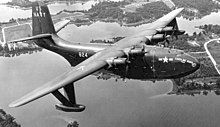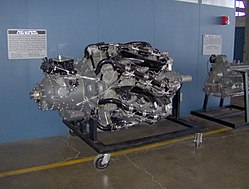Pratt & Whitney R-4360
| Pratt & Whitney | |
|---|---|
|
Pratt & Whitney R-4360 |
|
| R-4360 Wasp Major | |
| Production period: | 1944-1955 |
| Manufacturer: | Pratt & Whitney |
| Working principle: | Otto |
| Motor design: | Quadruple radial engine |
| Valve control: | OHV |
| Displacement: | 71,490 cm 3 |
| Mixture preparation: | Carburetor |
| Engine charging: | Radial compressor, turbocharger, intercooler |
| Power: | 2200 to 3200 kW |
| Previous model: | none |
| Successor: | none |

The US-based Pratt & Whitney R-4360 Wasp Major is one of the largest aircraft - radial engines , which during the Second World War were developed and built. Its displacement is 71.5 liters or 4,360 cubic inches ; hence the type designation. It is the last of the P&W "Wasp" series and the culmination of Pratt & Whitney piston engine development . But it was only built into the last generation of large propeller aircraft after the end of the war, which was soon replaced by jet-powered aircraft.
construction
The R-4360 was a four-row air-cooled radial engine with 28 cylinders, the cylinders of each level being arranged slightly offset for better cooling air supply. So it was not a series radial engine , but a multiple radial engine . A compressor running at six times the crankshaft speed charged the intake air, while a 2: 1 gearbox reduced the propeller speed in order not to let the blade tips run at supersonic speed.
The four seven-cylinder stars were each offset by 12.857 ° (360 ° / 7 cylinders / 4 rows), so that the rear cylinders looked through between the front ones and each got the most effective airflow possible for cooling. Its one-piece, five-bearing crankshaft had four cranks that were offset one after the other by 192.857 ... ° - the crank pin offset angles were 0 ° (1st crank pin), 192.857 ° (2nd crank pin), 25.714 ° (3rd crank pin) and 218.571 ° (4th crank pin). This resulted in an even firing sequence (one ignition per 25.714 ° crankshaft revolution). To ensure smooth running, the oscillating masses on the crank pins were balanced by two fixed and two bifilar counterweights. As a two-valve engine, the Wasp Major had a total of 28 intake and 28 exhaust valves that were pushrod-controlled . The ignition was done by two spark plugs per cylinder.
power

The first series developed 2200 kW (3000 bhp) take-off power, while towards the end of the construction period they were already able to deliver 2,834 kW (3800 bhp). With a weight of 1580 to 1750 kg, they were efficient engines with a low power-to-weight ratio , which only a few engines could achieve. From 1947 Pratt & Whitney worked on the R-4360 VDT (variable discharge turbine), this variant should be charged by a turbocharger instead of a compressor . This freed up part of the engine power that was previously used by the compressor ; it contributed to a considerable increase in drive power to 3,207 kW (4300 bhp). The R-4360 VDT was tested in flight on a Boeing B-50 in 1948. Development problems and the great advances in the development of jet engines , however, led to the termination of the VDT program. The last and most powerful development stage of the R-4360 remained a prototype and was never used on the aircraft intended for it, such as the Convair B-36 F or Boeing B-54.
commitment
A total of 18,679 units of this type of engine was produced from 1944 to 1955. They were originally planned for the Boeing B-29 Superfortress , but these were then renamed the B-50 when the R-4360 was in use .
Other aircraft:
- Hughes H-4 Hercules (Spruce Goose)
The engine was nicknamed " corn cob " because of its appearance . The only other example of such a quadruple radial engine is the Soviet Schwezow ASch-2K , which also has 28 cylinders and air cooling.
Technical data R-4360-59B (Boeing KC-97F Stratofreighter)
- Construction: air-cooled 28-cylinder quadruple radial engine with seven cylinders each in four levels
- Principle of operation: valve-controlled four-stroke - gasoline engine
- Supercharging : a single-stage turbocharger - intercooler - a radial compressor
- Propeller : Hamilton Standard 34G60
- Fuel: AvGas 115/145
- Stroke: 152 mm
- Bore: 146 mm
- Displacement : 71.5 liters
- Compression : 6.7: 1
- Working pressure with starting power and a fuel consumption of 1100 kg / h: approx. 16.22 bar
- Maximum take-off power : 2600 kW (3500 bhp ) at 2700 rpm (2 bar boost pressure )
- Maximum continuous output: 2000 kW (2700 bhp) at 2550 rpm (1.69 bar boost pressure)
- Travel power: 1300 kW (1735 bhp) at 2100 rpm (1.25 bar boost pressure)
- Compressor ratio: 6.375: 1
- Propeller ratio: 0.375: 1
- Mixture formation: pressure carburetor Bendix PR-100B3-4
- Ignition distributor : 4 × Scintilla S14RN-15
- Ignition time: 20 ° before TDC (optional 30 °)
- Turbocharger : GE 7SBH-4B1 (BH-4)
- Dry matter: 1673 kg
- Diameter: 1397 mm
- Length: 2451 mm
- specific power: 36.12 kW / l
- Power-to-weight ratio: 0.64 kg / kW
- specific consumption: 265 g / kWh
See also
- Schwezow ASch-2K
- Pratt & Whitney R-2800
- Wright R-3350
- Wright R-4090
- Mitsubishi Ha-50
- Hitachi Ha-51
- List of aircraft engines
Web links
- Pratt & Whitney "Classic Engines" R-4360 Wasp Major
- National Museum of the USAF datasheet
- "3,500 hp Radial - Pratt & Whitney Wasp Major," Flight , issue v. July 3, 1947, page 1081 ff. , Available online at flightglobal.com - Aviation History - PDF archive, in English - accessed on May 9, 2015
Individual evidence
- ^ Gerard L. Blake: Operating the Pratt & Whitney R-4360-59B. (No longer available online.) Archived from the original on November 5, 2016 ; accessed on November 6, 2016 . Info: The archive link was inserted automatically and has not yet been checked. Please check the original and archive link according to the instructions and then remove this notice.
- ^ Graham White: R-4360 Pratt & Whitney's Major Miracle . ISBN 978-1-58007-173-4 .

